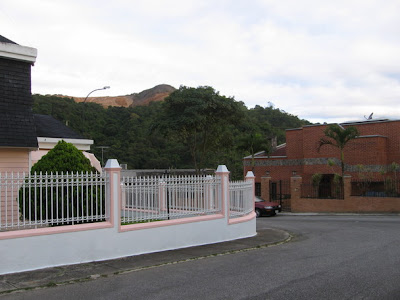As Caracas has quintupled in population over the past half century, habitation has become one of the fundamental divides in the city. Informal development is widely reported to currently represent up to 2/3 of the residential settlement within the metro area. The 2/3 of the population that live in the informal barrios are the same 2/3 of the population that are impoverished. Thus the differences in housing characteristics in Caracas vividly represent the city’s class division, which profoundly influences other elements drawn into tension in the city.
As most of the known readers of this blog are in the allied built environment professions, I will not go into detail describing the home building techniques of the Caracas barrios. Worldwide, these techniques are fairly similar: the necessary common traits are extreme thrift and resourcefulness. One way the Venezuelan ranchos (shanties) do literally rise above the pack is in visual prominence. As the conventionally developable bottomland of the Caracas valley is claimed by the formal city, the informal barrios must expand up the steep hillsides surrounding the plateau. The resulting development is both visually stunning and frightening. The ranchos are, unfortunately, as precariously perched as they seem. Landslides too often sweep the houses and inhabitants from the hills.
The specific details of middle to upper-class residential development in Caracas are also far from unique. Gated and, increasingly, fortified suburban-style communities are common, as barrios looming on the bluffs above constantly remind of the perceived security threat from nearby grinding poverty. Urban Think Tank in Caracas estimates that over $1 trillion is spent on private security in the city each year.
Through decades of evolution of the divergent housing sectors in Caracas, various efforts have been made to provide affordable public housing as an alternative to barrios for the poor. Most famously, in 1950, C. R. Villanueva designed Corbusian super bloques to replace the sprawling informal development in the city. The bloques were to provide affordable housing in 20,000 apartments, but after construction in the 50s, the military elite expropriated the units. Then, in 1958, poor Caraquenos physically retook the bloques in a popular uprising overthrowing Dictator Jimenez. The development was rechristened 23 de Enero to commemorate the day (January 23) of the dictator’s ouster. Eventually, the giant bloques themselves became the physical source of electricity and water supporting barrios growing up mercilessly around the blocks.
I believe I will let that brief description and analysis suffice.It seems pictures may best tell the rest of the story regarding housing in Caracas... Click on the photos to zoom in.
In Caracas, the barrios are in your face, composing the majority of settlement in the city. Given the force of those numbers, housing issues continue to be held in tension in the city, weighted to the degree that the mayor recently discussed the possibility of closing the city's famous Olmsted golf course to build public housing on the links. The situation seems somewhat unlike that in many other S&M cities. In Abuja, over 800,000 people have been displaced by bulldozing of informal settlements over the recent years. In Brasilia, informal development is tolerated but relegated to satellite villages well outside of sight fro the central city. In New Belgrade, authorities are engineering plans to eradicate a successional stage of informal housing undergrowth overtaking spaces left vacant by massive bloque construction similar to that in Caracas.
Despite prevailing world sentiment pushing toward bourgeois resolution, Caracas continues to engage in a running, and built, dialogue regarding habitation.
I believe I will let that brief description and analysis suffice.It seems pictures may best tell the rest of the story regarding housing in Caracas... Click on the photos to zoom in.
 |
| Gated Mansion Communities in Caracas |
 |
| Good Fences Make Good Mansions |
 |
| The Dark Side - Caracas Barrio |
 |
| 1950 23 de Enero Super Bloques - Intended to Replace Barrios |
 |
| 23 de Enero - Supporting (Being Slowly Consumed By) Barrio |
 |
| Informal Meets Formal - Caracas |
 |
| In Living Color - Caracas Barrio |
No comments:
Post a Comment